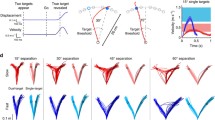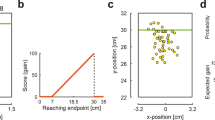Abstract
We investigated the effect of spatial uncertainty on motor planning by using the cueing method in a reaching task (experiment 1). Discrete spatial cues indicated the different locations in which the target could be presented. The number of cues as well as their direction changed from trial to trial. We tested the adequacy of two models of motor planning to account for the data. The switching model assumes that only one motor response can be planned at a time, whereas the capacity-sharing model assumes that multiple motor responses can be planned in parallel. Both models predict the same relation between average reaction time (RT) and number of cues, but they differ in their prediction of the shape of the distribution of the reaction time. The results showed that RT increased with the number of cues independently from their spatial dispersion. This relation was well described by the function predicted by both models, whereas it was poorly described by the Hick-Hyman law. In addition, the distribution of RT conformed to the prediction of the capacity-sharing model and not to that of the switching model. We investigated the role that the requirement of a spatially directed motor response might have had on this pattern of results by testing subjects in a simple RT task (experiment 2) with the same cueing presentation as in experiment 1. The results contrasted with those in experiment 1 and showed that RT was dependent on the spatial dispersion of the cues and not on their number. The results of the two experiments suggest that the mode of processing of potential targets is dependent on the spatial constraints of the task. The processing resources can be either divided relative to the spatial distribution of possible targets or across multiple independent discrete representations of these targets.









Similar content being viewed by others
References
Alexander GE (1987) Selective neuronal discharge in monkey putamen reflects intended direction of planned limb movements. Exp Brain Res 67:623–634
Basso MA, Wurtz RH (1998) Modulation of neuronal activity in superior colliculus by changes of target probability. J Neurosci 15:7519–7534
Bastian A, Riehle A, Erlhagen W, Schöner G (1998) Prior information preshapes the population representation of movement direction in motor cortex. Neuroreport 9:315–319
Battaglia Mayer A, Ferraina S, Marconi B, Bullis JB, Lacquaniti F, Burnod Y, Baraduc P, Caminiti R (1998) Early motor influences on visuomotor transformations for reaching: a positive image of optic ataxia. Exp Brain Res 123:172–189
Bernstein IH, Schurman DL, Forester G (1967) Choice reaction time as a function of stimulus uncertainty, response uncertainty, and behavioral hypotheses. J Exp Psychol 74:517–524
Bock O, Arnold K (1992) Motor control prior to movement onset: preparatory mechanisms for pointing at visual targets. Exp Brain Res 90:209–216
Bock O, Eversheim U (2000) The mechanisms of movement preparation: a precuing study. Behav Brain Res 108:85–90
Brainard RW, Irby TS, Fitts PM, Alluisi EA (1962) Some variables influencing the rate of gain of information. J Exp Psychol 63:105–110
Broadbent DE, Gregory M (1965) On the interaction of S-R compatibility with other variables affecting reaction time. Br J Psychol 56:61–67
Carey DP (2000) Eye-hand coordination: eye to hand or hand to eye? Curr Biol 10: R416–R419
Castiello U (2001) The effects of abrupt onset of 2-D and 3-D distractors on prehension movements. Percept Psychophys 63:1014–1025
Cisek P, Kalaska JF (2002) Simultaneous encoding of multiple potential reach directions in dorsal premotor cortex. J Neurophysiol 87:1149–1154
Dassonville P, Lewis SM, Foster HE, Ashe J (1999) Choice and stimulus-response compatibility affect duration of response selection. Cogn Brain Res 7:235–240
Dunnett CW (1955) A multiple comparison procedure for comparing several treatments with a control. J Am Stat Assoc 50:1096–1121
Eriksen CW, Yeh YY (1985) Allocation of attention in the visual field. J Exp Psychol Hum Percept Perform 11:583–597
Evarts EV, Tanji J (1976) Reflex and intended responses in motor cortex pyramidal tract neurons of monkey. J Neurophysiol 39:1069–1080
Favilla M (1996) Reaching movements: programming time course is independent of choice number. Neuroreport 7:2629–2634
Favilla M (2002) Reaching movements: mode of motor programming influences programming itself. Exp Brain Res 144:414–418
Fitts PM, Peterson JR (1964) Information capacity of discrete motor responses. J Exp Psychol 67:103–112
Fitts PM, Peterson JR, Wolpe G (1963) Cognitive aspects of information processing: II. Adjustments to stimulus redundancy. J Exp Psychol 65:423–432
Genest C (2000) Vincentization revisited. Ann Stat 20:1137–1142
Ghez C, Favilla M, Ghilardi MF, Gordon J, Bermejo R, Pullman S (1997) Discrete and continuous planning of hand movements and isometric force trajectories. Exp Brain Res 115:217–233
Hick WE (1952) On the rate of gain of information. Q J Exp Psychol 4:11–26
Hyman R (1953) Stimulus information as a determinant of reaction time. J Exp Psychol 45:188–196
Jaeger D, Gilman S, Aldridge JW (1993) Primate basal ganglia activity in a precued reaching task: preparation for movement. Exp Brain Res 95:51–64
Lee D (1999) Effects of exogenous and endogenous attention on visually guided hand movements. Cogn Brain Res 8:143–156
Leonard JA (1959) Tactual choice reactions: I. Q J Exp Psychol 11:76–83
Longstreth LE, El-Zahhar N, Alcorn MB (1985) Exceptions to Hick's law: explorations with a response duration measure. J Exp Psychol Gen 114:417–434
Luce RD (1986) Response times. Their role in inferring elementary mental organization. Oxford Science Publications, New York
Mardia KV, Jupp PE (2000) Directional statistics. John Wiley & Sons, Chichester
Pellizzer G, Georgopoulos AP (1993) Common processing constraints for visuomotor and visual mental rotations. Exp Brain Res 93:165–172
Pellizzer G, Sargent P, Georgopoulos P (1995) Motor cortical activity in a context-recall task. Science 269:702–705
Podgorny P, Shepard RN (1983) Distribution of visual attention over space. J Exp Psychol Hum Percept Perform 9:380–393
Prut Y, Fetz EE (1999) Primate spinal interneurons show pre-movement instructed delay activity. Nature 401:590–594
Ratcliff R (1979) Group reaction time distributions and an analysis of distribution statistics. Psychol Bull 86:446–461
Ratcliff R (1993) Methods for dealing with reaction time outliers. Psychol Bull 114:510–532
Rosenbaum DA (1980) Human movement initiation: specification of arm, direction, and extent. J Exp Psychol Gen 109:444–474
Shaw ML (1978) A capacity allocation model for reaction time. J Exp Psychol Hum Percept Perform 4:586–598
Snedecor GW, Cochran WG (1989) Statistical methods, 8th edn. Iowa State University Press, Ames
Sokal RR, Rohlf FJ (1995) Biometry, 3rd edn. Freeman and Co, New York
Teichner WH, Krebs, MJ (1974) Laws of choice reaction time. Psychol Rev 81:75–98
Tipper SP, Howard LA, Houghton G (1998) Action-based mechanisms of attention. Philos Trans R Soc Lond B Biol Sci 353:1385–1393
Yantis S, Jonides J (1996) Attentional capture by abrupt onsets: new perceptual objects or visual masking. J Exp Psychol Hum Percept Perform 22:1505–1513
Yantis S, Meyer DE, Smith JEK (1991) Analyses of multinomial mixture distributions: new tests for stochastic models of cognition and action. Psychol Bull 110:350–374
Author information
Authors and Affiliations
Corresponding author
Additional information
The authors wish to thank Ramon R. Villanueva for participating in the collection of part of the data and Bagrat Amirikian for comments on a previous version of the manuscript
This research was supported by a Merit Review Award from the Medical Research Service of the Department of Veterans Affairs
Rights and permissions
About this article
Cite this article
Pellizzer, G., Hedges, J.H. Motor planning: effect of directional uncertainty with discrete spatial cues. Exp Brain Res 150, 276–289 (2003). https://doi.org/10.1007/s00221-003-1453-1
Received:
Accepted:
Published:
Issue Date:
DOI: https://doi.org/10.1007/s00221-003-1453-1




